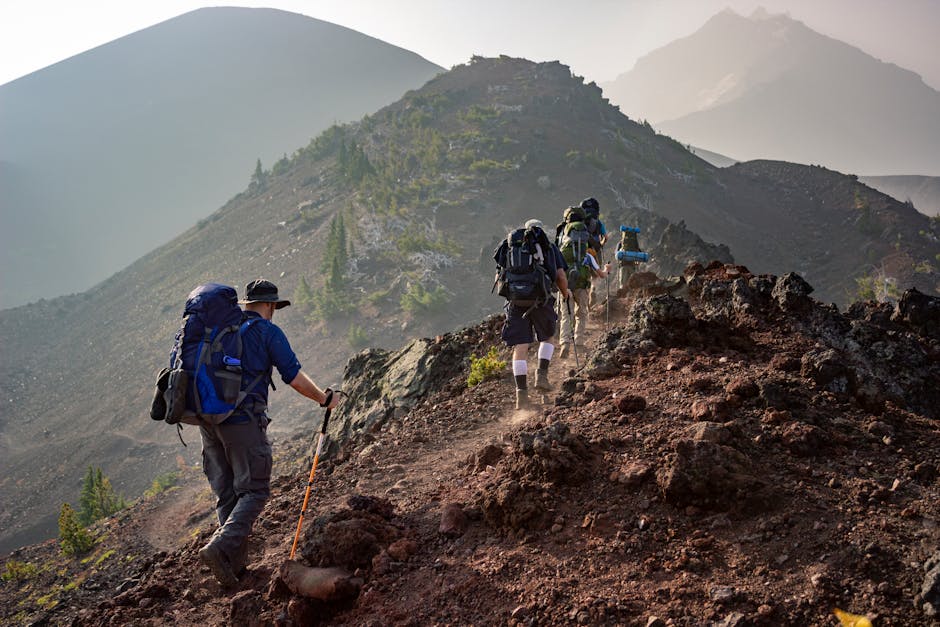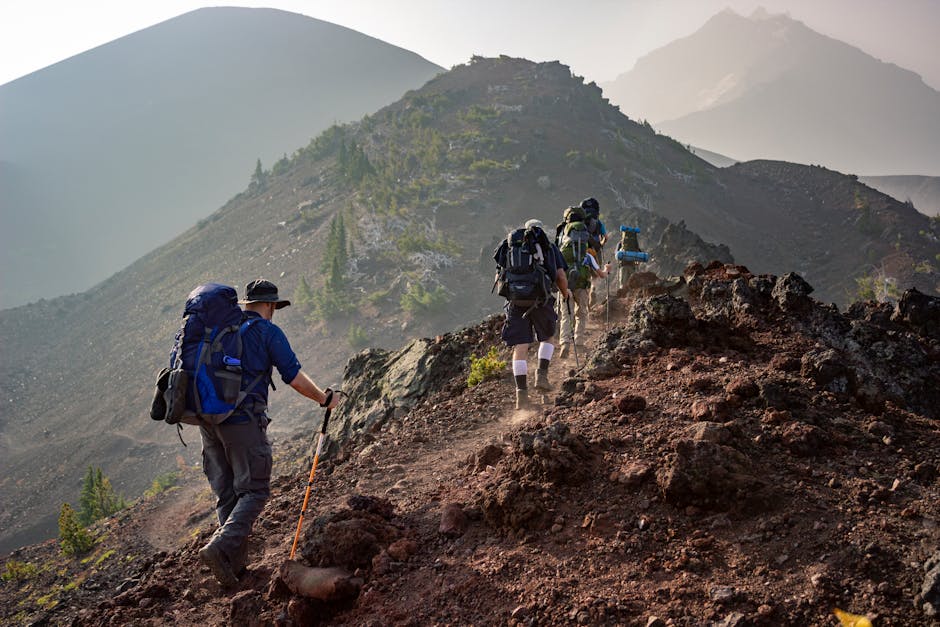Table of Contents
- Introduction
- The Importance of Goal Setting in Leadership
- Overcoming Challenges and Adversity in Performance
- Building Resilience and Mental Toughness
- Teamwork and Collaboration in High-Pressure Situations
- Decision-Making and Problem-Solving Skills
- Effective Communication Strategies in Leadership
- Embracing Change and Adaptability
- Self-Reflection and Personal Growth in Performance
- Leading by Example and Inspiring Others
- Q&A
- Conclusion
“Unleash your potential at the top of the world.”
Introduction
Lessons in Performance and Leadership from Trekking the Himalayas: Trekking in the Himalayas is a challenging and rewarding experience that can teach valuable lessons in performance and leadership. The rugged terrain, high altitudes, and unpredictable weather conditions require individuals to push themselves beyond their limits and work together as a team to achieve their goals. Through this journey, participants can learn important skills such as resilience, adaptability, communication, and decision-making, which are essential for success in both personal and professional settings. By reflecting on their experiences in the Himalayas, individuals can gain valuable insights into how to improve their performance and leadership abilities in any situation.
The Importance of Goal Setting in Leadership
Setting goals is a fundamental aspect of leadership, as it provides direction, motivation, and a sense of purpose for both individuals and teams. The process of goal setting involves identifying specific objectives, creating a plan to achieve them, and monitoring progress along the way. In the world of business, effective goal setting is crucial for driving performance and achieving success.
One of the key lessons in performance and leadership that can be learned from trekking the Himalayas is the importance of setting clear and ambitious goals. When embarking on a challenging trek, such as the Everest Base Camp trek, climbers set their sights on reaching the summit. This goal serves as a powerful motivator, pushing them to overcome obstacles, endure physical hardships, and stay focused on the ultimate objective.
Similarly, in the corporate world, leaders must set ambitious goals that inspire and challenge their teams to perform at their best. By setting clear and specific objectives, leaders can create a sense of purpose and direction for their employees, driving motivation and engagement. When employees have a clear understanding of what is expected of them and what they are working towards, they are more likely to stay focused, committed, and driven to succeed.
Another important lesson in performance and leadership that can be gleaned from trekking the Himalayas is the need for flexibility and adaptability in goal setting. While reaching the summit may be the ultimate goal for climbers, they must be willing to adjust their plans and strategies in response to changing conditions, unforeseen challenges, and unexpected obstacles. Flexibility is key to overcoming setbacks, staying on track, and ultimately achieving success.
In the business world, leaders must also be flexible and adaptable in their approach to goal setting. As market conditions change, new opportunities arise, and unforeseen challenges emerge, leaders must be willing to adjust their goals, strategies, and plans accordingly. By remaining agile and responsive, leaders can navigate uncertainty, seize opportunities, and drive performance in a rapidly changing environment.
Furthermore, trekking the Himalayas teaches valuable lessons in resilience and perseverance, which are essential qualities for effective leadership. Climbers face a myriad of challenges on their journey to the summit, including extreme weather conditions, altitude sickness, physical exhaustion, and mental fatigue. To succeed, climbers must demonstrate resilience, perseverance, and a never-give-up attitude.
Similarly, in the corporate world, leaders must possess resilience and perseverance to navigate challenges, setbacks, and failures. By staying resilient in the face of adversity, leaders can inspire their teams, maintain morale, and drive performance even in the most challenging circumstances. Leaders who demonstrate perseverance and determination are more likely to overcome obstacles, achieve their goals, and lead their organizations to success.
In conclusion, trekking the Himalayas offers valuable lessons in performance and leadership that can be applied to the world of business. By setting clear and ambitious goals, remaining flexible and adaptable, and demonstrating resilience and perseverance, leaders can inspire their teams, drive performance, and achieve success. Effective goal setting is a critical component of leadership, providing direction, motivation, and purpose for individuals and teams. By embracing the lessons learned from trekking the Himalayas, leaders can enhance their leadership skills, drive performance, and lead their organizations to new heights of success.
Overcoming Challenges and Adversity in Performance
Trekking the Himalayas is a challenging and rewarding experience that can teach valuable lessons in performance and leadership. The journey through the world’s highest mountain range requires physical endurance, mental strength, and the ability to overcome obstacles along the way. These same qualities are essential for success in any endeavor, whether it be in the workplace, on the sports field, or in personal relationships.
One of the key lessons learned from trekking the Himalayas is the importance of perseverance in the face of adversity. The terrain can be unforgiving, with steep inclines, rocky paths, and unpredictable weather conditions. It is easy to become discouraged when faced with such challenges, but pushing through and continuing on the journey is essential for reaching the ultimate goal.
In the same way, in the workplace or in leadership roles, there will inevitably be obstacles and setbacks that must be overcome. It is important to stay focused on the end goal and not let temporary setbacks derail progress. By maintaining a positive attitude and a determination to succeed, individuals can overcome even the most difficult challenges.
Another important lesson from trekking the Himalayas is the value of teamwork and collaboration. The journey is not one that can be completed alone – it requires the support and assistance of fellow trekkers, guides, and porters. Working together as a team, sharing responsibilities, and helping each other through difficult moments are all essential for success.
In a professional setting, teamwork is also crucial for achieving goals and overcoming challenges. Leaders must be able to build strong teams, delegate tasks effectively, and foster a sense of camaraderie among team members. By working together towards a common goal, individuals can achieve more than they ever could on their own.
Trekking the Himalayas also teaches the importance of adaptability and flexibility. The journey is unpredictable, with weather conditions changing rapidly and unexpected obstacles arising along the way. Trekkers must be able to adapt to these changes, adjust their plans accordingly, and remain flexible in their approach.
Similarly, in the workplace, leaders must be able to adapt to changing circumstances, make quick decisions, and pivot when necessary. Being able to think on your feet, remain calm under pressure, and adjust to new situations is essential for success in any leadership role.
Finally, trekking the Himalayas teaches the value of self-care and resilience. The journey is physically and mentally demanding, requiring trekkers to take care of themselves, listen to their bodies, and practice self-care along the way. Resting when needed, staying hydrated, and nourishing the body with healthy food are all essential for maintaining energy and stamina throughout the journey.
In the same way, in leadership roles, it is important to prioritize self-care and resilience. Leaders must take care of themselves, both physically and mentally, in order to be effective in their roles. By practicing self-care, managing stress, and prioritizing well-being, individuals can build the resilience needed to overcome challenges and thrive in their leadership roles.
In conclusion, trekking the Himalayas offers valuable lessons in performance and leadership that can be applied to any aspect of life. By persevering in the face of adversity, working together as a team, adapting to changing circumstances, and prioritizing self-care, individuals can overcome challenges, achieve their goals, and succeed in their leadership roles. The lessons learned from trekking the Himalayas are timeless and universal, offering valuable insights for anyone seeking to improve their performance and leadership skills.
Building Resilience and Mental Toughness
Trekking the Himalayas is not just a physical challenge; it is also a mental and emotional journey that can teach valuable lessons in performance and leadership. The harsh conditions, unpredictable weather, and rugged terrain test not only your physical endurance but also your mental toughness and resilience. As you navigate through the mountains, facing obstacles and pushing yourself beyond your limits, you learn important skills that can be applied to various aspects of life, including performance and leadership.
One of the key lessons that trekking the Himalayas teaches is the importance of resilience. In the face of adversity, such as extreme weather conditions or difficult terrain, it is essential to stay resilient and keep pushing forward. This resilience is not just about physical strength but also about mental fortitude. When faced with challenges, it is crucial to stay focused, maintain a positive attitude, and keep moving forward, no matter how difficult the situation may seem.
Another important lesson that trekking the Himalayas teaches is the value of mental toughness. The long hours of trekking, the steep ascents and descents, and the physical exhaustion can all take a toll on your mental strength. However, by pushing through these challenges and staying mentally tough, you can build a strong mindset that will help you overcome obstacles in other areas of your life. Mental toughness is about staying focused, staying motivated, and staying resilient in the face of adversity.
Trekking the Himalayas also teaches important lessons in leadership. As you trek through the mountains with a group of fellow trekkers, you have the opportunity to practice and develop your leadership skills. Leading a group through challenging terrain requires effective communication, decision-making, and problem-solving skills. It also requires the ability to motivate and inspire others, to keep them going when the going gets tough. By taking on a leadership role during the trek, you can learn valuable lessons in leading a team and achieving common goals.
In addition to resilience, mental toughness, and leadership skills, trekking the Himalayas also teaches the importance of teamwork. The mountains are a harsh and unforgiving environment, and it is essential to work together with your fellow trekkers to overcome challenges and reach your destination safely. By working as a team, supporting each other, and sharing the load, you can achieve more than you ever could on your own. Teamwork is about collaboration, communication, and trust, and these skills are essential for success in any performance or leadership role.
Overall, trekking the Himalayas is a transformative experience that can teach valuable lessons in performance and leadership. By building resilience, mental toughness, leadership skills, and teamwork, you can become a stronger, more effective leader and performer in all areas of your life. The challenges and obstacles you face in the mountains will test your limits and push you to grow and develop as a person. So, if you ever have the opportunity to trek the Himalayas, seize it with both hands and embrace the journey of self-discovery and growth that awaits you.
Teamwork and Collaboration in High-Pressure Situations

Trekking the Himalayas is not just a physical challenge; it is also a test of mental strength, teamwork, and leadership. The harsh conditions, high altitudes, and unpredictable weather make it a high-pressure situation that requires individuals to work together effectively to achieve their goals. In this article, we will explore the lessons in performance and leadership that can be learned from trekking the Himalayas, specifically focusing on the importance of teamwork and collaboration in such challenging environments.
One of the key lessons that can be learned from trekking the Himalayas is the importance of effective communication within a team. In high-pressure situations, clear and concise communication is essential for ensuring that everyone is on the same page and working towards a common goal. Without effective communication, misunderstandings can arise, leading to confusion, frustration, and ultimately, failure. By practicing open and honest communication, team members can share information, ideas, and feedback, leading to better decision-making and problem-solving.
Another important lesson from trekking the Himalayas is the value of trust and mutual respect within a team. In challenging environments, individuals must rely on each other for support, encouragement, and assistance. Trusting in the abilities and intentions of your team members is crucial for building strong relationships and fostering a sense of unity and camaraderie. By demonstrating respect for each other’s strengths, weaknesses, and perspectives, team members can work together more effectively, leveraging each other’s skills and expertise to overcome obstacles and achieve success.
Furthermore, teamwork and collaboration in high-pressure situations require individuals to be adaptable and flexible in their approach. The unpredictable nature of the Himalayan terrain and weather means that plans can change at a moment’s notice, requiring team members to be able to adjust their strategies and tactics accordingly. By remaining open-minded and willing to adapt to new circumstances, individuals can respond more effectively to challenges and opportunities, maximizing their chances of success.
In addition to communication, trust, and adaptability, effective teamwork and collaboration in high-pressure situations also require strong leadership. A good leader is someone who can inspire, motivate, and guide their team towards a common goal, even in the face of adversity. By setting a positive example, providing clear direction, and offering support and encouragement, a leader can help to build a cohesive and high-performing team that is capable of overcoming any obstacle.
Ultimately, the lessons in performance and leadership from trekking the Himalayas can be applied to a wide range of professional and personal settings. Whether you are leading a team in the workplace, participating in a group project at school, or working towards a common goal with friends or family, the principles of effective teamwork and collaboration remain the same. By practicing open communication, building trust and mutual respect, remaining adaptable and flexible, and demonstrating strong leadership, individuals can work together more effectively to achieve their objectives and reach new heights of success.
In conclusion, trekking the Himalayas offers valuable insights into the importance of teamwork and collaboration in high-pressure situations. By learning from the challenges and experiences of such expeditions, individuals can develop the skills and qualities needed to work effectively with others, overcome obstacles, and achieve their goals. Whether you are trekking through the mountains or navigating the complexities of the modern world, the lessons in performance and leadership from the Himalayas can help you to reach new heights of success.
Decision-Making and Problem-Solving Skills
Trekking in the Himalayas is not just a physical challenge; it is also a test of mental strength, decision-making, and problem-solving skills. The rugged terrain, unpredictable weather, and high altitudes present numerous obstacles that require quick thinking and adaptability. As a result, those who embark on such a journey often come away with valuable lessons in performance and leadership that can be applied to various aspects of their lives.
One of the key lessons learned from trekking in the Himalayas is the importance of making quick and informed decisions. In such a challenging environment, there is often little room for hesitation or indecision. Every step must be carefully considered, and any delays can have serious consequences. This teaches trekkers to trust their instincts, gather information quickly, and make decisions with confidence.
Moreover, trekking in the Himalayas also teaches valuable problem-solving skills. When faced with unexpected obstacles such as a sudden change in weather or a difficult terrain, trekkers must think on their feet and come up with creative solutions. This requires a combination of analytical thinking, creativity, and resourcefulness. By navigating through these challenges, trekkers learn to adapt to changing circumstances and find solutions to complex problems.
In addition to decision-making and problem-solving skills, trekking in the Himalayas also teaches important lessons in leadership. In a group setting, such as a trekking expedition, effective leadership is essential for ensuring the safety and well-being of all team members. Leaders must be able to inspire and motivate others, make tough decisions, and lead by example. Through their experiences in the mountains, trekkers learn the importance of clear communication, teamwork, and collaboration in achieving common goals.
Furthermore, trekking in the Himalayas also teaches trekkers the value of resilience and perseverance. The physical and mental challenges of trekking at high altitudes can be overwhelming at times, testing one’s endurance and determination. Trekkers learn to push through their limits, overcome obstacles, and keep moving forward despite setbacks. This resilience and perseverance are valuable traits that can be applied to any challenging situation in life.
Overall, trekking in the Himalayas offers a unique opportunity to develop essential skills in decision-making, problem-solving, and leadership. The lessons learned from such an experience can be applied to various aspects of life, whether in the workplace, at home, or in personal relationships. By facing and overcoming the challenges of the mountains, trekkers emerge stronger, more confident, and better equipped to tackle whatever obstacles come their way.
In conclusion, trekking in the Himalayas is not just a physical adventure; it is also a journey of self-discovery and personal growth. The lessons in performance and leadership learned from such an experience are invaluable and can have a lasting impact on one’s life. By honing their decision-making, problem-solving, and leadership skills in the mountains, trekkers emerge as stronger, more resilient individuals ready to take on whatever challenges lie ahead.
Effective Communication Strategies in Leadership
Trekking the Himalayas is not just a physical challenge; it is also a test of mental strength, endurance, and leadership skills. As a leader, navigating through the rugged terrain and unpredictable weather conditions of the Himalayas can provide valuable lessons in effective communication strategies.
One of the key lessons learned from trekking in the Himalayas is the importance of clear and concise communication. In a high-stress environment where decisions need to be made quickly, effective communication can mean the difference between success and failure. Leaders must be able to convey their thoughts and instructions clearly to their team members, ensuring that everyone is on the same page and working towards a common goal.
Another important aspect of communication in leadership is active listening. In the Himalayas, where the terrain is challenging and the weather conditions are unpredictable, it is crucial for leaders to listen to their team members’ concerns, ideas, and feedback. By actively listening to their team members, leaders can gain valuable insights into the situation at hand and make informed decisions that benefit the entire group.
Furthermore, effective communication in leadership also involves providing timely and constructive feedback. In the Himalayas, where every decision can have a significant impact on the team’s success, leaders must be able to provide feedback to their team members in a way that is both timely and constructive. By offering feedback that is specific, actionable, and focused on improvement, leaders can help their team members grow and develop their skills, ultimately leading to better performance and success.
In addition to clear communication, effective leadership in the Himalayas also requires strong decision-making skills. Leaders must be able to make quick and informed decisions in high-pressure situations, taking into account the input of their team members and the overall goals of the expedition. By making decisions that are based on sound judgment and a clear understanding of the situation, leaders can guide their team through the challenges of the Himalayas and towards their ultimate goal.
Moreover, effective leadership in the Himalayas also involves building trust and fostering a sense of teamwork among team members. In a challenging environment like the Himalayas, where every member of the team plays a crucial role in the group’s success, it is essential for leaders to build trust and create a sense of camaraderie among team members. By fostering a supportive and collaborative team environment, leaders can inspire their team members to work together towards a common goal, ultimately leading to greater success and achievement.
In conclusion, trekking in the Himalayas provides valuable lessons in effective communication strategies for leadership. From clear and concise communication to active listening, timely feedback, strong decision-making skills, and building trust and teamwork, the challenges of the Himalayas can help leaders develop the skills they need to succeed in any high-pressure environment. By applying these lessons learned from the Himalayas to their leadership roles, leaders can inspire and motivate their team members, navigate through challenges with confidence, and achieve their goals with success.
Embracing Change and Adaptability
Trekking the Himalayas is not just a physical challenge; it is also a mental and emotional journey that can teach valuable lessons in performance and leadership. One of the key lessons that can be learned from trekking in the Himalayas is the importance of embracing change and adaptability.
The Himalayas are a dynamic and ever-changing environment, with unpredictable weather, challenging terrain, and constantly shifting conditions. As trekkers navigate through this rugged landscape, they must be prepared to adapt to whatever challenges come their way. This ability to embrace change and adaptability is crucial not only for survival in the mountains but also for success in any leadership role.
In the business world, as in the mountains, change is inevitable. Markets shift, technologies evolve, and competition intensifies. Leaders who are able to adapt quickly and effectively to these changes are more likely to succeed in the long run. Just as trekkers must be prepared to adjust their plans and strategies in response to changing conditions, business leaders must be willing to pivot and innovate in order to stay ahead of the curve.
One of the key ways that trekkers learn to embrace change and adaptability is by being open to new experiences and perspectives. In the mountains, trekkers are often faced with unfamiliar challenges and obstacles that require them to think creatively and problem-solve on the fly. By approaching these challenges with an open mind and a willingness to learn, trekkers can develop the resilience and flexibility needed to thrive in a constantly changing environment.
Similarly, in the business world, leaders must be open to new ideas and perspectives in order to stay competitive. By fostering a culture of innovation and encouraging employees to think outside the box, leaders can create a dynamic and adaptable organization that is able to respond effectively to changing market conditions.
Another important lesson in performance and leadership that can be learned from trekking in the Himalayas is the value of perseverance and resilience. The mountains are a harsh and unforgiving environment, where trekkers must push themselves to their physical and mental limits in order to reach their goals. By persevering through the challenges and setbacks that inevitably arise on the trail, trekkers develop the grit and determination needed to succeed in any endeavor.
In the business world, as in the mountains, perseverance and resilience are essential qualities for effective leadership. Leaders who are able to weather the storms and bounce back from failure are more likely to inspire confidence and loyalty in their teams. By demonstrating a willingness to push through adversity and never give up, leaders can set an example for their employees and create a culture of resilience within their organization.
Ultimately, trekking in the Himalayas offers valuable lessons in performance and leadership that can be applied to any aspect of life. By embracing change and adaptability, being open to new experiences and perspectives, and cultivating perseverance and resilience, trekkers can develop the skills and qualities needed to succeed in the mountains and beyond. Whether navigating the rugged terrain of the Himalayas or the ever-changing landscape of the business world, the lessons learned on the trail can help leaders reach new heights of success and fulfillment.
Self-Reflection and Personal Growth in Performance
Trekking the Himalayas is not just a physical challenge; it is also a mental and emotional journey that can teach valuable lessons in performance and leadership. The rugged terrain, high altitudes, and unpredictable weather conditions push trekkers to their limits, forcing them to dig deep within themselves to find the strength and resilience to keep going. In the process, they learn important lessons that can be applied to various aspects of life, including personal growth, performance, and leadership.
One of the key lessons that trekking the Himalayas teaches is the importance of perseverance and resilience. The long and arduous trek requires trekkers to keep pushing forward, even when they are tired, sore, and facing seemingly insurmountable obstacles. This ability to persevere in the face of adversity is a crucial skill in both personal and professional life. Whether it’s overcoming a challenging project at work or dealing with a difficult personal situation, the resilience gained from trekking the Himalayas can help individuals stay focused and determined in the face of obstacles.
Another important lesson that trekking the Himalayas teaches is the value of teamwork and collaboration. Trekking in such harsh conditions requires trekkers to rely on each other for support, encouragement, and assistance. By working together as a team, trekkers can overcome challenges that would be impossible to tackle alone. This spirit of teamwork and collaboration is essential in any organization or team, as it fosters a sense of unity, trust, and mutual respect among team members. By learning to work together effectively on the trek, individuals can apply these skills to their professional lives, leading to improved performance and better outcomes.
Trekking the Himalayas also teaches trekkers the importance of goal setting and planning. Before embarking on the trek, trekkers must set clear goals for themselves, such as reaching a certain peak or completing a specific route. They must also carefully plan their route, taking into account factors such as weather conditions, terrain, and altitude. By setting clear goals and developing a detailed plan, trekkers can stay focused and motivated throughout the journey, increasing their chances of success. This lesson in goal setting and planning is crucial in personal and professional life, as it helps individuals stay organized, motivated, and on track to achieve their objectives.
In addition to these lessons in performance and leadership, trekking the Himalayas also provides trekkers with a unique opportunity for self-reflection and personal growth. The solitude and beauty of the mountains offer a peaceful environment for introspection, allowing trekkers to reflect on their values, beliefs, and goals. This self-reflection can lead to greater self-awareness, clarity, and personal growth, helping individuals become more confident, resilient, and self-assured.
Overall, trekking the Himalayas is a transformative experience that can teach valuable lessons in performance and leadership. By persevering through challenges, working together as a team, setting clear goals and plans, and engaging in self-reflection, trekkers can develop important skills and qualities that can benefit them in all areas of life. Whether it’s in the workplace, at home, or in personal relationships, the lessons learned from trekking the Himalayas can help individuals become more effective leaders, better performers, and happier, more fulfilled individuals.
Leading by Example and Inspiring Others
Trekking in the Himalayas is not just a physical challenge; it is also a test of mental strength, perseverance, and leadership. The rugged terrain, high altitudes, and unpredictable weather conditions make it a daunting task for even the most experienced hikers. However, those who successfully complete a trek in the Himalayas often come away with valuable lessons in performance and leadership that can be applied to various aspects of their lives.
One of the key lessons that can be learned from trekking in the Himalayas is the importance of leading by example. When embarking on a challenging trek, it is essential for the group to have a strong leader who can set the pace, make decisions, and motivate others to keep going. A good leader is someone who is not afraid to take on difficult tasks, who remains calm under pressure, and who is willing to put the needs of the group above their own.
During a trek in the Himalayas, there are bound to be moments when the going gets tough, and it is during these times that true leaders emerge. By demonstrating resilience, determination, and a positive attitude, a leader can inspire others to push through their own challenges and reach their goals. Leading by example means showing others that it is possible to overcome obstacles, no matter how daunting they may seem.
In addition to leading by example, trekking in the Himalayas also teaches valuable lessons in inspiring others. When faced with a steep climb, a treacherous descent, or a sudden change in weather, it is important for the group to come together and support one another. By offering words of encouragement, lending a helping hand, or simply being there to listen, each member of the group can inspire others to keep going and not give up.
Inspiring others is not just about offering words of encouragement; it is also about showing empathy, compassion, and understanding. By taking the time to listen to others, to offer support when needed, and to celebrate each other’s successes, a group can create a sense of camaraderie and unity that will help them overcome any challenge that comes their way.
Ultimately, the lessons in performance and leadership that can be learned from trekking in the Himalayas are applicable to all areas of life. Whether in the workplace, in sports, or in personal relationships, the qualities of a good leader – resilience, determination, and a positive attitude – are essential for success. By leading by example and inspiring others, individuals can achieve their goals, overcome obstacles, and reach new heights of achievement.
In conclusion, trekking in the Himalayas is not just a physical challenge; it is also a valuable learning experience that can teach important lessons in performance and leadership. By leading by example, inspiring others, and demonstrating resilience and determination, individuals can achieve their goals and inspire others to do the same. The next time you face a challenge, remember the lessons you learned in the Himalayas and use them to guide you on your journey to success.
Q&A
1. What are some key lessons in performance and leadership that can be learned from trekking the Himalayas?
– The importance of goal-setting and perseverance
– The value of teamwork and collaboration
– The need for adaptability and resilience
2. How can trekking the Himalayas help develop leadership skills?
– By facing challenges and making decisions in a high-pressure environment
– By leading and motivating a team through difficult terrain and conditions
– By learning to communicate effectively and delegate tasks
3. What role does performance play in trekking the Himalayas?
– Performance is crucial for reaching the summit and completing the trek
– It requires physical and mental endurance, as well as strategic planning and execution
– Performance can be measured by factors such as distance covered, altitude gained, and overall team success
4. How can lessons learned from trekking the Himalayas be applied to leadership in other contexts?
– By applying the same principles of goal-setting, teamwork, and adaptability
– By drawing on the experience of overcoming challenges and pushing through adversity
– By using the skills and confidence gained from trekking to lead and inspire others in different settings
5. What are some specific examples of leadership challenges faced while trekking the Himalayas?
– Navigating difficult terrain and weather conditions
– Managing team dynamics and conflicts
– Making quick decisions in high-stress situations
6. How can trekking the Himalayas help individuals develop their performance mindset?
– By pushing physical and mental limits to achieve a challenging goal
– By learning to stay focused and motivated in the face of obstacles
– By gaining confidence and self-belief through overcoming challenges
7. What are some key takeaways for leaders from trekking the Himalayas?
– The importance of setting clear goals and staying focused on them
– The value of teamwork and collaboration in achieving success
– The need for adaptability and resilience in the face of unexpected challenges
8. How can leaders apply the lessons learned from trekking the Himalayas to improve their performance in the workplace?
– By setting ambitious yet achievable goals for themselves and their teams
– By fostering a culture of teamwork and collaboration within their organization
– By developing their own adaptability and resilience to navigate change and uncertainty
9. In what ways can trekking the Himalayas help individuals develop their leadership potential?
– By providing opportunities to practice decision-making and problem-solving in a challenging environment
– By fostering teamwork and communication skills through working with a diverse group of individuals
– By building confidence and resilience through overcoming physical and mental challenges
Conclusion
Trekking the Himalayas can provide valuable lessons in performance and leadership, such as resilience, teamwork, adaptability, and decision-making skills. These experiences can help individuals develop as effective leaders and performers in various aspects of their lives.





